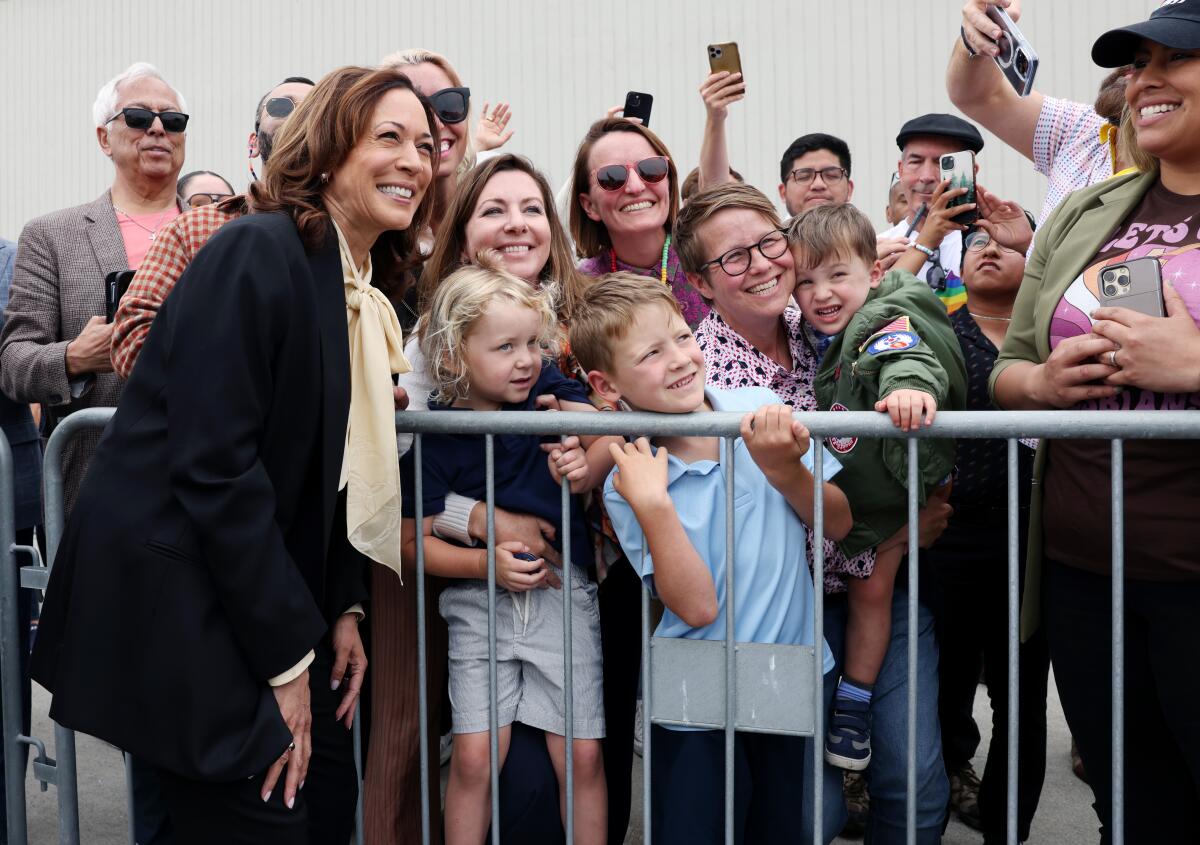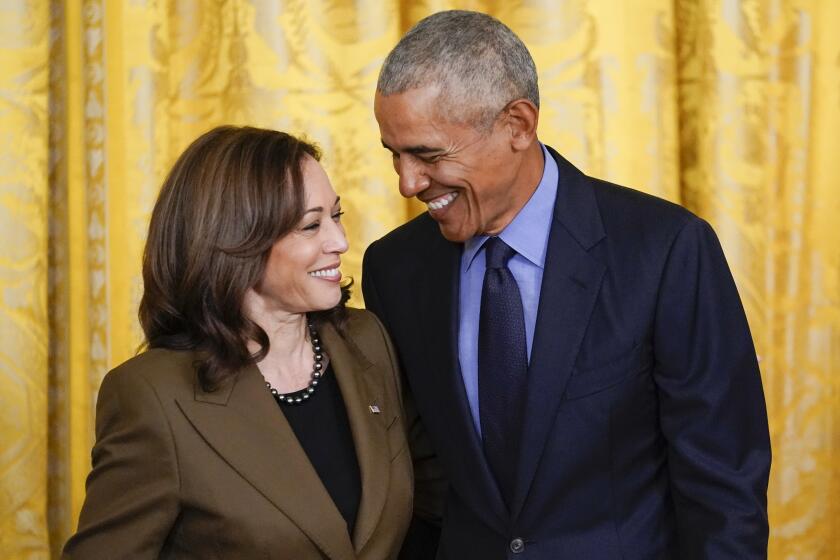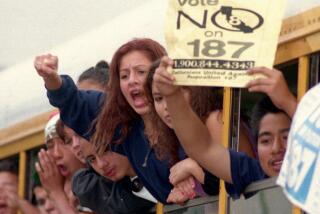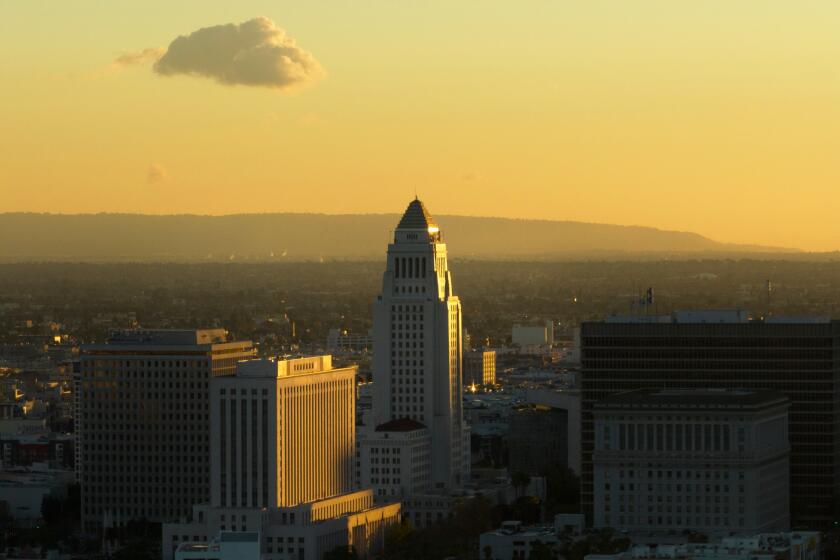Harris leads Trump in California, but Latino support softens, poll shows

- Share via
- Former President Trump has little hope of winning California, the poll found.
- Just 5% of those polled were undecided.
- The vice president leads Trump among California Latinos but by a smaller margin than President Biden won by four years ago.
Vice President Kamala Harris maintains a commanding lead over former President Trump in California, but Trump’s gains among the state’s Latino voters highlight a troubling sign for Democrats at the national level, according to a new poll.
Harris’ 57%-35% overall lead in California over Trump is little changed from her August margin of 59% to 34%, according to the survey by UC Berkeley’s Institute of Governmental Studies, co-sponsored by The Times.
The state’s streak of voting Democratic in every presidential election since 1988, when President George H.W. Bush beat Michael Dukakis, is unlikely to be broken. Its 54 electoral votes — the largest prize on election day — are all but certain to go to Harris.
Harris’ lead among Latinos in the state is similar to her overall margin, 54% to 35%. But that represents a sharp decline from President Biden’s margin in 2020, when exit polls showed he beat Trump 75% to 23% among California Latinos.
That new poll jibes with other national and swing state surveys that show an erosion in Democratic support from a group of voters who have been a core segment of the party’s coalition in recent decades. That shift began in 2020, when Biden lost ground among Latino voters compared with Hillary Clinton, the Democratic nominee in 2016.
Harris leads Trump by an average of 2 to 3 percentage points in national polls, but the race for electoral votes is seen as a toss-up.
Two of the seven swing states — Arizona and Nevada — have large Latino populations that are likely to be decisive. Latino voters could also make a difference in other battleground states where their numbers are smaller — such as Georgia, North Carolina and Pennsylvania — given that polls show exceedingly close races.
Kamala Harris was introduced to much of the nation as the next Barack Obama. The comparison has been a blessing and a burden.
“If any place is supposed to have the most happy Latinos, the most progressive Latinos, it’s here,” said Cristina Mora, co-director of the Institute of Governmental Studies and an expert on immigration and racial politics. “But they’re experiencing the pain points of inequality.”
Latinos, who make up about 3 in 10 voters in California, have been among the hardest hit by the state’s housing crisis and by the effects of inflation, which has subsided in recent months but has left high prices in its wake. A lack of progress from the Biden administration on immigration reform also has dampened enthusiasm among progressive Latinos, Mora said.
Trump has benefited from frustration among several segments of the Latino population, including many second- and third-generation families, despite his history of employing incendiary tropes, including claims that immigrants are “poisoning the blood of our country” and taking “Black jobs.”
Latino voters in swing states could help decide the 2024 presidential election. Here’s a look at what that electorate looks like in places like Arizona, Nevada and Georgia.
Harris, the first South Asian American and first Black woman to lead a presidential ticket, also has lost some support among Asian and Black voters compared with 2020, but they remain key parts of her coalition. She has support from 66% of Asian/Pacific Islanders and 72% of Black voters in California.
Harris has made up some of those losses in California with white voters, among whom she leads Trump 56% to 37%, a wider margin than Biden’s 51%-47% advantage in 2020. That margin coincides with another national trend — the drift of college-educated white voters to the Democratic Party while non-college-educated voters move toward Trump.
Trump has a small lead among white Californians without a college degree; Harris leads resoundingly among voters who have one, according to the poll.
That educational split also helps explain some of Trump’s gains among Black and Latino voters without degrees.
The poll found only a sliver of likely voters — 5% — remain undecided, similar to the national polling average showing 5.6%. But the poll’s relatively large sample size of more than 3,000 voters allowed for more detailed insights among that group than other polls typically provide.
These undecided voters are more likely to view Trump in a negative light (55% to 31%) than Harris (43% to 39%), and they are more likely to believe Trump is too extreme and a risk to democracy if elected president. But at the same time, they expect Trump would do better at managing the economy and foreign affairs and “has the toughness to be president,” compared with Harris.
These voters see deep flaws in Trump and are more likely to view Harris as a uniter, said Mark DiCamillo, director of the poll. “But they still think on a number of these attributes he’d be the stronger candidate.”
The two campaigns are aware of that paradox among the late-deciding voters and are honing their messages in the campaign’s final weeks in hopes of winning them over.
Harris is running ads featuring Trump’s former advisors denouncing him as unfit to serve and others reminding voters of his role in inciting the Jan. 6, 2021, insurrection; other ads tout her plans for the economy. Trump’s commercials have been centered on inflation and other economic issues, along with those targeting Harris on immigration and transgender rights, among other topics.
Despite the focus on undecided voters, most Americans who intend to cast ballots have already made up their minds. But they see the candidates’ ideologies through different lenses.
California voters of all stripes tend to see Trump as conservative. But views on Harris vary. A third of her voters see her as moderate and only 5% see her as “very liberal” whereas more than 80% of Trump voters see her as very liberal.
More to Read
Get the L.A. Times Politics newsletter
Deeply reported insights into legislation, politics and policy from Sacramento, Washington and beyond. In your inbox three times per week.
You may occasionally receive promotional content from the Los Angeles Times.













